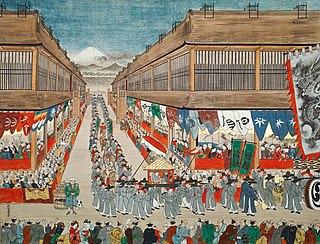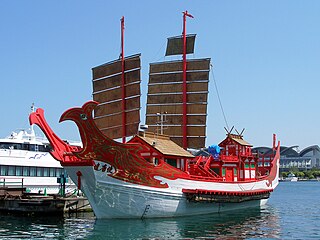Related Research Articles

The Japanese missions to Imperial China were diplomatic embassies which were intermittently sent to the Chinese imperial court. Any distinction amongst diplomatic envoys sent from the Japanese court or from any of the Japanese shogunates was lost or rendered moot when the ambassador was received in the Chinese capital.

Tenshō (天正) was a Japanese era name after Genki and before Bunroku. This period spanned the years from July 1573 through December 1592. The reigning emperors were Ōgimachi-tennō (正親町天皇) and Go-Yōzei-tennō (後陽成天皇).

Ōei (応永) was a Japanese era name after Meitoku and before Shōchō. This period spanned the years from July 1394 through April 1428. Reigning emperors were Go-Komatsu-tennō (後小松天皇,) and Shōkō-tennō (称光天皇).

The Joseon Tongsinsa (Korean: 조선통신사) were goodwill missions sent intermittently, at the request of the resident Japanese authority, by Joseon dynasty Korea to Japan. The Korean noun identifies a specific type of diplomatic delegation and its chief envoys. From the Joseon diplomatic perspective, the formal description of a mission as a tongsinsa signified that relations were largely "normalized," as opposed to missions that were not called tongsinsa.
Yang Su was a Korean diplomat and ambassador, representing Joseon interests in a diplomatic mission to the Ashikaga shogunate in Japan.

Joseon missions to Japan represent a crucial aspect of the international relations of mutual Joseon-Japanese contacts and communication. In sum, these serial diplomatic ventures illustrate the persistence of Joseon's kyorin diplomacy from 1392 to 1910.
Hwang Sin was an officer of the Joseon Dynasty Korea in 16th and 17th centuries. In 1588, Hwang placed first in the final civil service examination (Mungwa).
The Korean state Joseon (1392–1897) sent numerous diplomatic missions to the Chinese states of Ming (1368–1644) and Qing (1636–1912).
Joseon diplomacy was the foreign policy of the Joseon dynasty of Korea from 1392 through 1910; and its theoretical and functional foundations were rooted in Neo-Confucian scholar-bureaucrats, institutions and philosophy.
Japanese missions to Joseon represent a crucial aspect of the international relations of mutual Joseon-Japan contacts and communication. The bilateral exchanges were intermittent.

The Japanese missions to Tang China were Japanese efforts to learn Chinese culture and civilization from Tang China, in the 7th, 8th and 9th centuries. The nature of those contacts evolved gradually from political and ceremonial change into cultural exchanges, and the process accompanied growing commercial ties which developed over time.
Japanese missions to Ming China represent a lens for examining and evaluating the relationships between China and Japan in the 15th through the 17th centuries. The nature of these bilateral contacts encompassed political and ceremonial acknowledgment as well as cultural exchanges. The evolution of diplomatic ties accompanied the growing commercial ties which grew over time.
Imperial Chinese missions to the Ryukyu Kingdom were diplomatic missions that were intermittently sent by the Yuan, Ming and Qing emperors to Shuri, Okinawa, in the Ryukyu Islands. These diplomatic contacts were within the Sinocentric system of bilateral and multinational relationships in the Sinosphere.
Sadae is a Korean term which is used in pre-modern contexts. Sadae is a Confucian concept, based on filial piety, that describes a reciprocal hierarchical relationship between a senior and a junior, such as a tributary relationship. The term is used as a descriptive label for bilateral foreign relations between Imperial China and Joseon dynasty Korea. Korea's sadae toward China was first employed by Silla in the 7th century, but it was not fully implemented until the Confucianization of Korea in the early Joseon dynasty. Korea's sadae toward China from the 7th century to the 13th century was only nominal.
Ryukyuan missions to Imperial China were diplomatic missions that were intermittently sent from the Ryukyuan kings to the Ming and Qing emperors. These diplomatic contacts were within the Sinocentric system of bilateral and multinational relationships in East Asia. A total of 347 Ryukyuan missions to China have been recorded.
Japanese missions to Sui China represent a lens for examining and evaluating the relationship between the Sui dynasty and Japan in the 7th century. The nature of these bilateral contacts evolved gradually from political and ceremonial acknowledgment to cultural exchanges; and the process accompanied the growing commercial ties which developed over time.

The tributary system of China, or Cefeng system was a network of loose international relations centered around China which facilitated trade and foreign relations by acknowledging China's hegemonic role within a Sinocentric world order. It involved multiple relationships of trade, military force, diplomacy and ritual. The other states had to send a tributary envoy to China on schedule, who would kowtow to the Chinese emperor as a form of tribute, and acknowledge his superiority and precedence. The other countries followed China's formal ritual in order to keep the peace with the more powerful neighbor and be eligible for diplomatic or military help under certain conditions. Political actors within the tributary system were largely autonomous and in almost all cases virtually independent.
Japanese missions to Baekje represent an aspect of the international relations of mutual Baekje-Japanese contacts and communication. The bilateral exchanges were intermittent.
References
- Kang, Etsuko Hae-jin. (1997). Diplomacy and Ideology in Japanese-Korean Relations: from the Fifteenth to the Eighteenth Century. Basingstoke, Hampshire; Macmillan. ISBN 978-0-312-17370-8; OCLC 243874305
- Nussbaum, Louis-Frédéric and Käthe Roth. (2005). Japan encyclopedia. Cambridge: Harvard University Press. ISBN 978-0-674-01753-5; OCLC 58053128
- Wang, Zhenping. (2005). Ambassadors from the Islands of Immortals: China-Japan Relations in the Han-Tang Period. Honolulu: University of Hawai'i Press. ISBN 9780824828714; OCLC 58647984